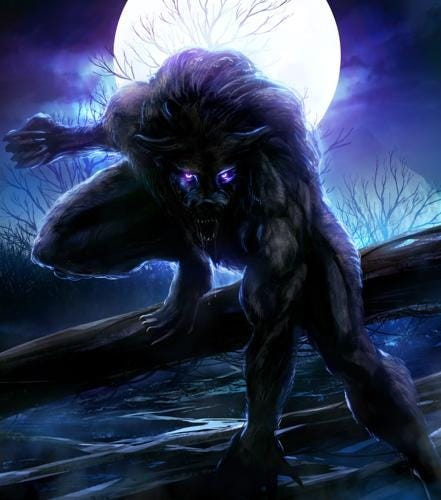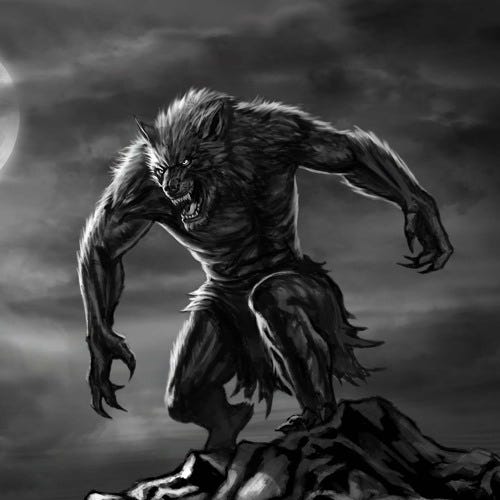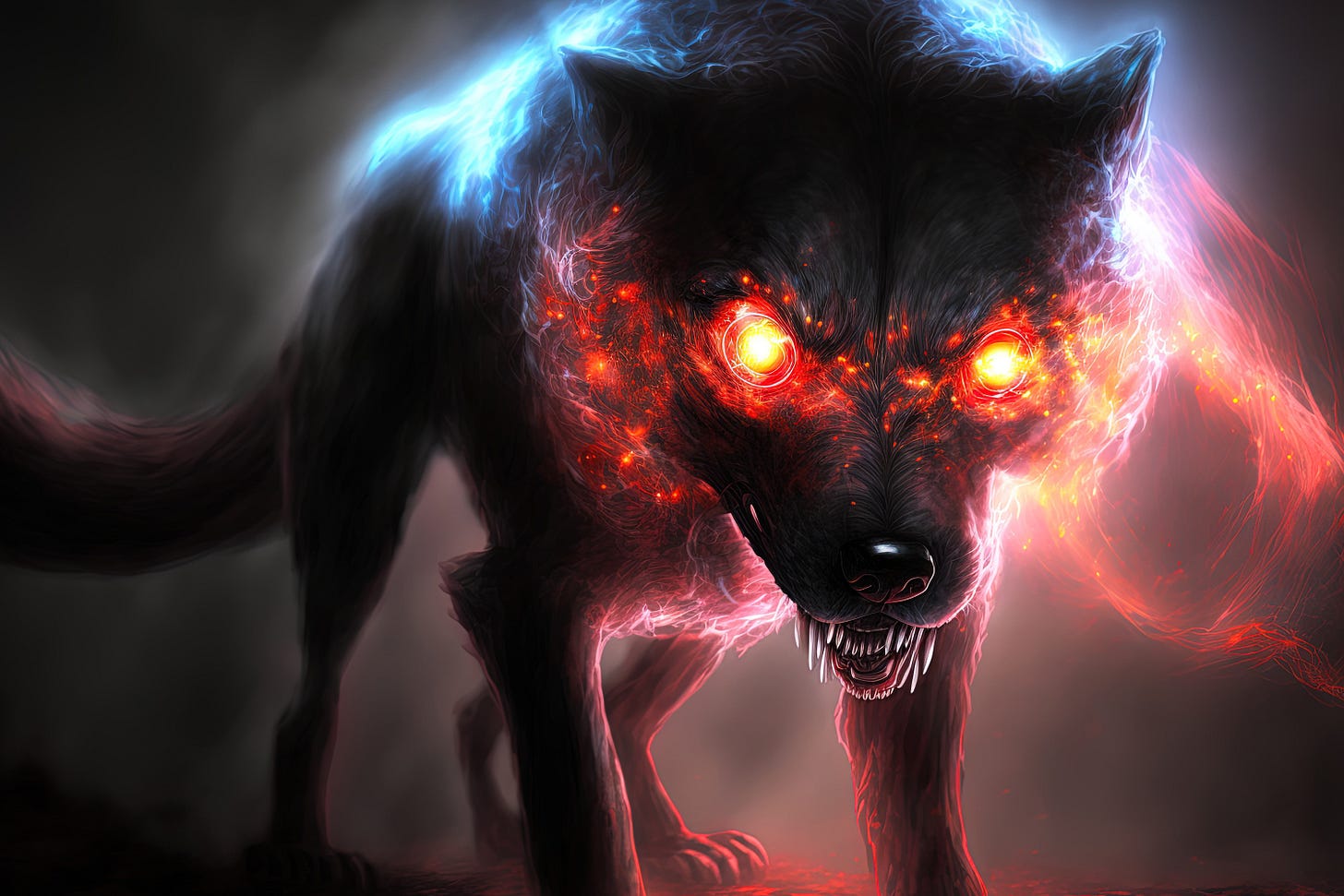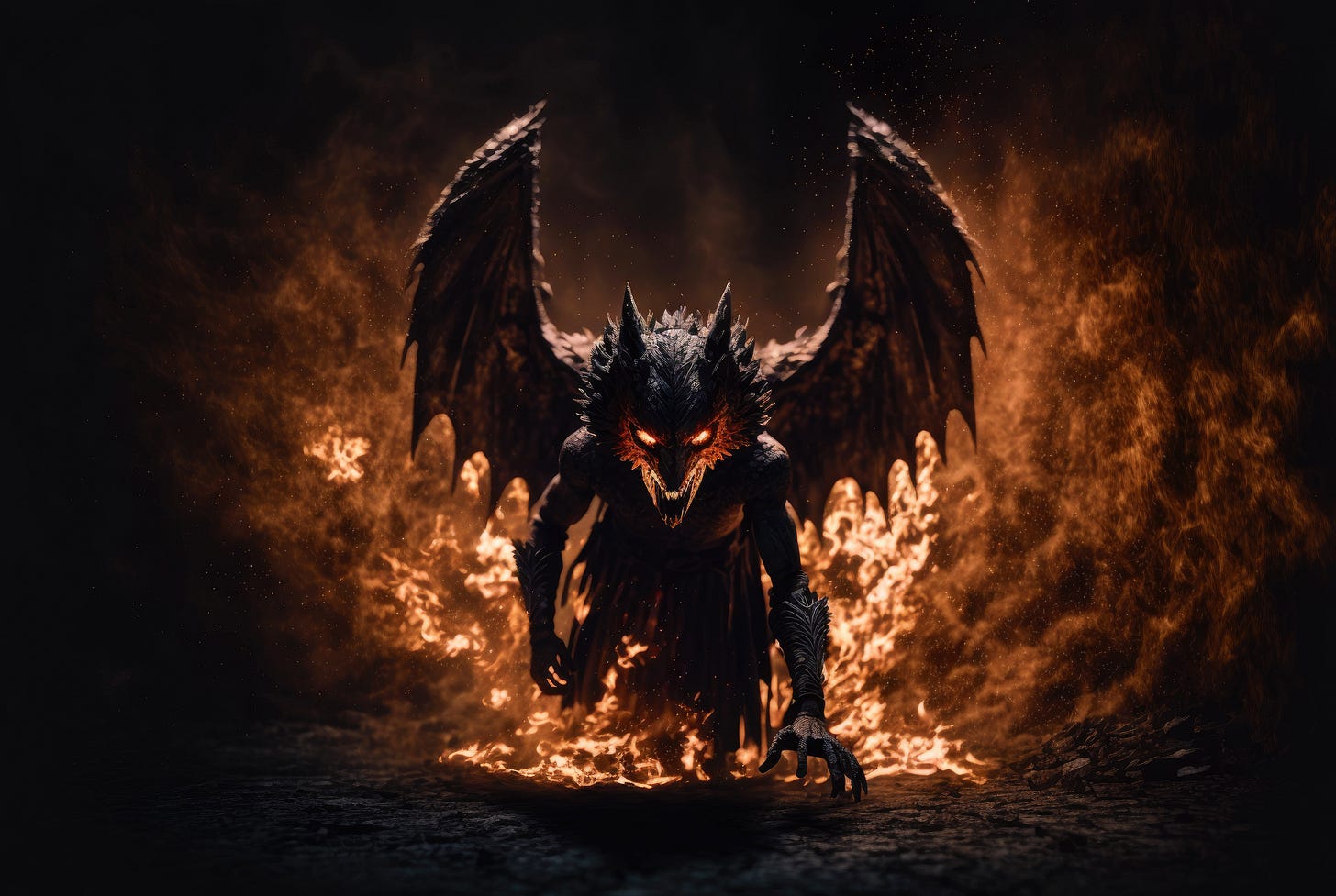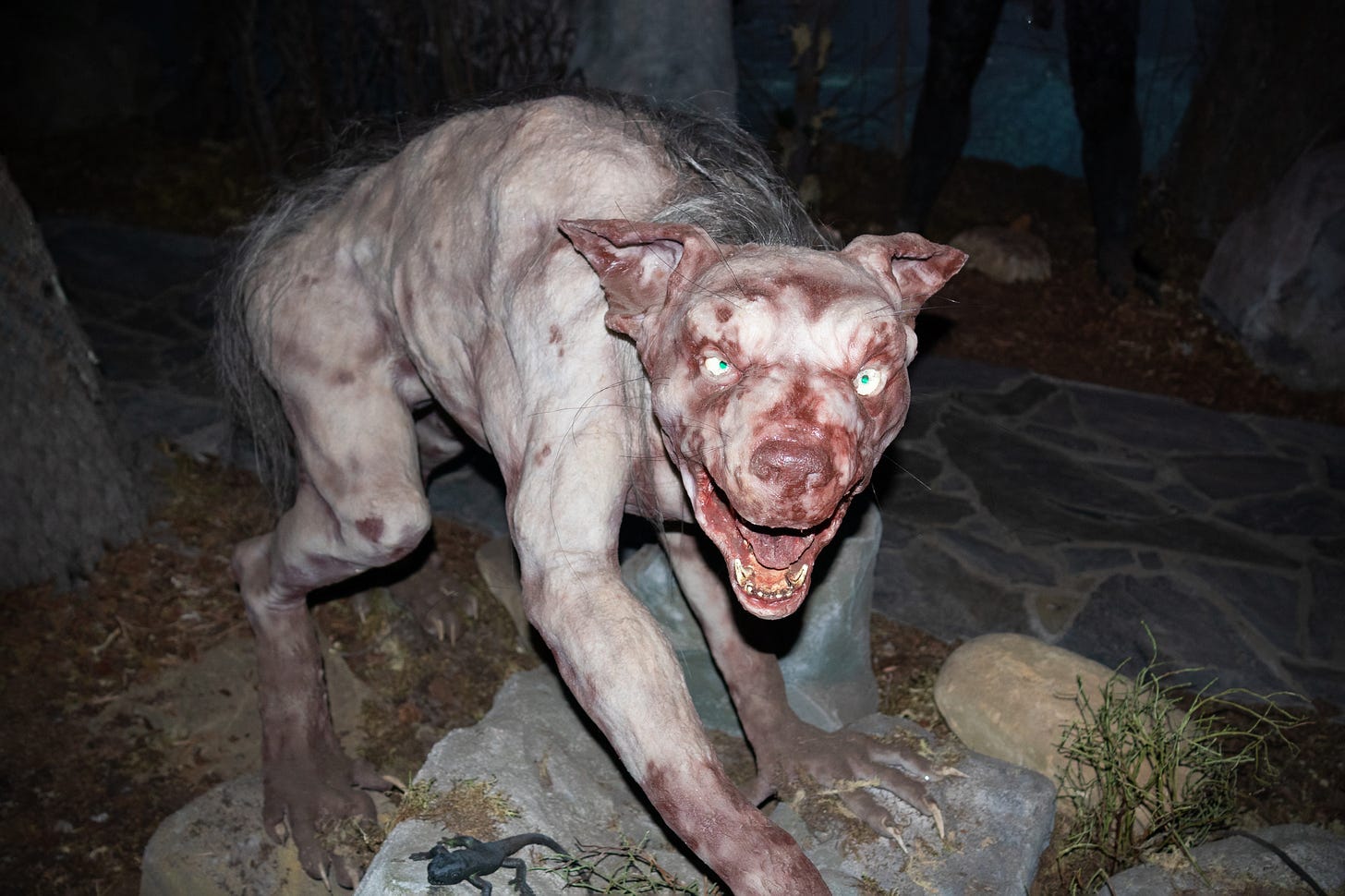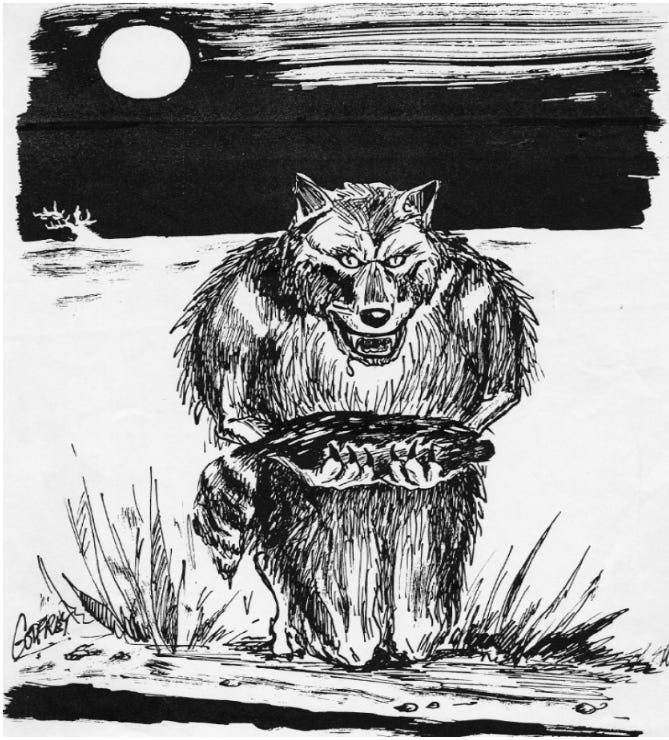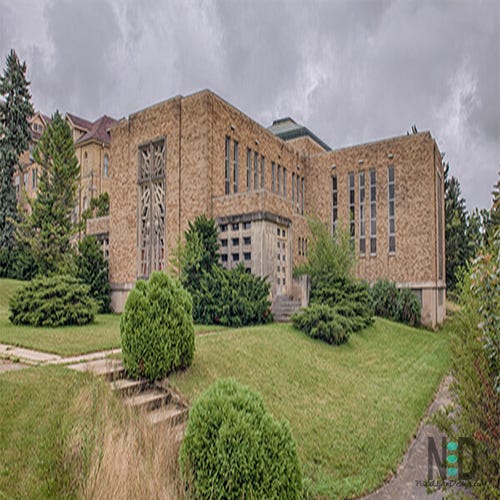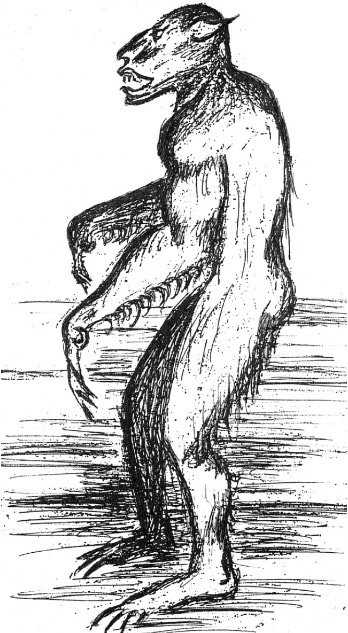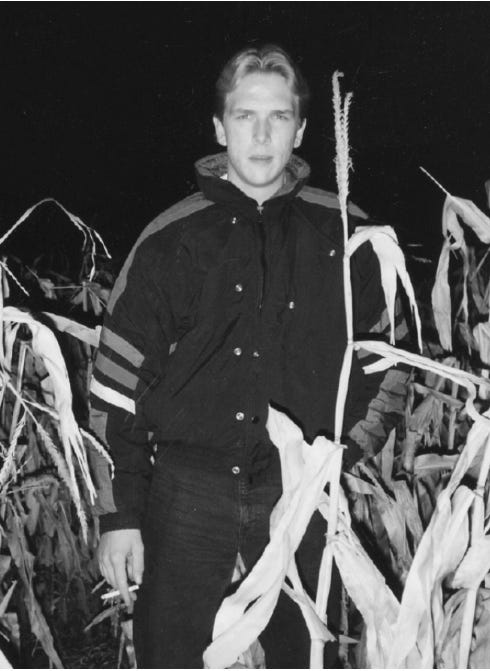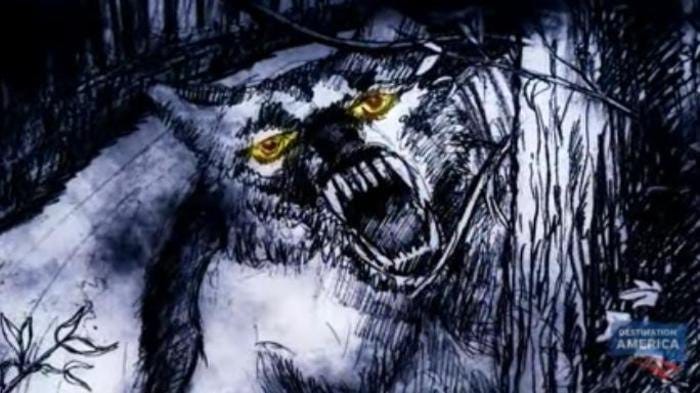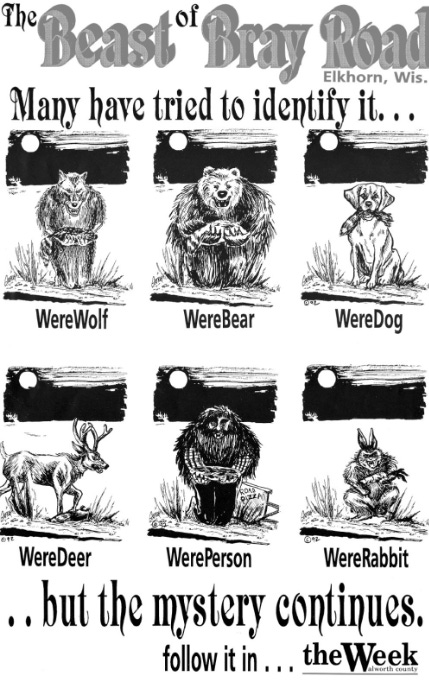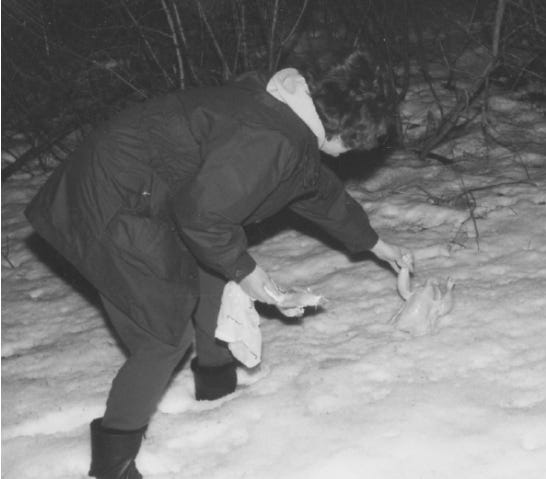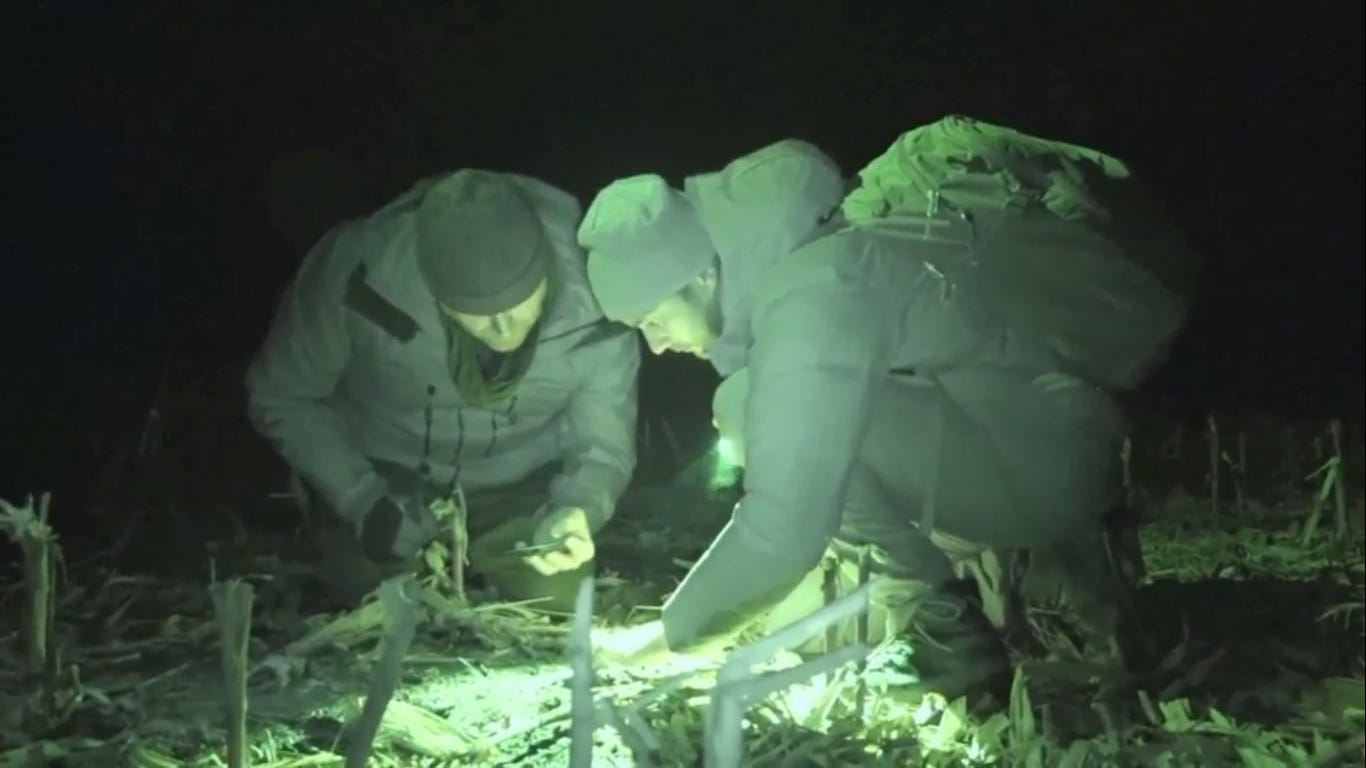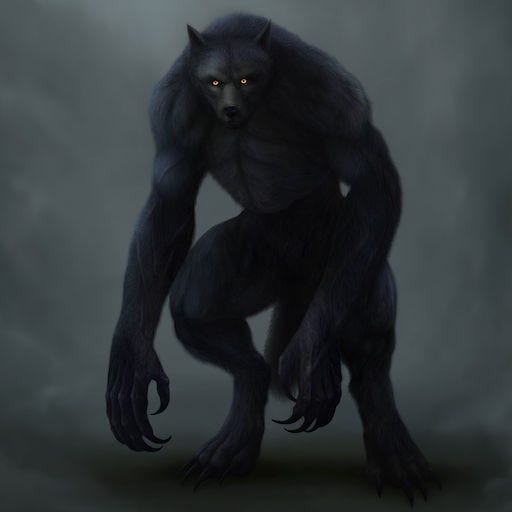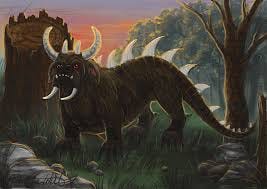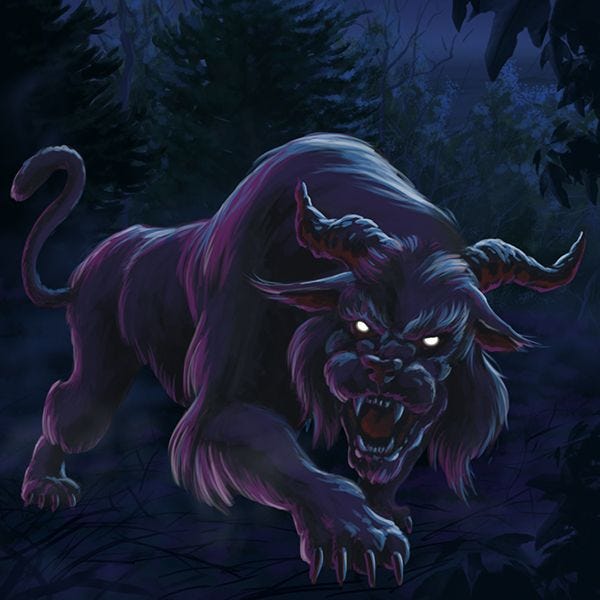In Elkhorn, Wisconsin, lies one of America’s most intriguing cryptid legends—the Beast of Bray Road. This creature has sparked curiosity for nearly a century, with sightings beginning in the early 1930s. Despite various investigations, the Beast's true nature remains elusive, adding to the intrigue surrounding this fading myth.
The Beast's origins intertwine local folklore, history, eyewitness accounts, and elements of the supernatural. It gained attention in the 1930s and saw a surge in reports during the late 1980s and early 1990s, with many sightings in the Elkhorn area. The first recorded encounter occurred in 1936 when Mark Schackelman spotted a wolf-like creature near Delavan—larger than any known wolf and walking on its hind legs.
Over the years, sightings continued, but it was Lori Endrizzi's 1989 account that propelled the Beast into the limelight. In her description, she detailed a massive, hairy creature walking on two legs, resembling a blend of werewolves and Bigfoot. Her account echoed earlier descriptions, fueling speculation about what roams the quiet roads of Elkhorn at night.
This article delves into the historical context of the Beast of Bray Road, its local impact, and the cultural significance that has cemented its status as a legendary figure in Wisconsin. We’ll examine various theories, ranging from cryptid and paranormal explanations to rational possibilities, uncovering the reasons behind its enduring fascination for both locals and cryptid enthusiasts.
The Origins of the Beast of Bray Road
The fascination with the Beast of Bray Road began in the early 1990s, but its roots run deeper in history. In December 1991, Linda Godfrey, a new reporter at the Walworth County Week, received a tip about rumors in Elkhorn of a werewolf-like creature in the cornfields. Although skeptical at first, Godfrey's curiosity led her to investigate, transforming a brief inquiry into a decades-long exploration of cryptids and paranormal phenomena. Her reporting brought the Beast into public view and made her synonymous with the creature.

While the Beast is a modern legend, the concept of werewolves has existed for millennia, with almost every culture having its own version. In North America, Native American tribes shared tales of shapeshifters believed to have spiritual connections. The Elkhorn area also has rich German and Scandinavian folklore featuring werewolves and dogmen. Over time, these cultural influences shaped the Beast of Bray Road’s mythos.
Eyewitness accounts vary widely, describing the Beast as a large, bipedal werewolf-like creature or a conventional wolf. Some view it as aggressive, while others see it as shy and elusive. The Beast's behavior and appearance have evolved with cultural trends, intertwining it with modern cryptozoology and linking it to other figures like Bigfoot and the Dogman of Michigan.
The Cultural Roots of the Beast of Bray Road
The Beast of Bray Road legend is a compelling blend of folklore from Native American, German, and Scandinavian traditions. These influences create a complex identity for the Beast, characterized by its strange appearance and behaviors. These influences have shaped our understanding of this creature, which has haunted Wisconsin’s roads for nearly a century.
Examining the Beast’s origins reveals how Native American shapeshifter myths, involving beings transforming between human and animal forms, interlace with European tales of werewolves, creatures capable of shifting due to curses or blessings. This fusion has developed a multifaceted legend that’s hard to define.
With the cultural roots established, let’s explore the theories explaining the Beast’s existence, shaped by eyewitness accounts and cryptozoological research over the years:
Werewolf/Shapeshifter
This is arguably the most popular theory, deeply rooted in both Native American and European folklore. The notion is that the Beast is a shapeshifter, capable of effortlessly transitioning between human and animal forms. Supporters of this theory believe the creature’s transformation is either magical or the result of a curse. However, there is a significant gap in the evidence that supports this theory. No eyewitness account has ever connected the Beast to a human counterpart, and no local resident has ever been suspected of being a shapeshifter. This absence of a human link makes the werewolf theory harder to substantiate, even though it remains an enticing part of the legend.
Bigfoot/Sasquatch
Another common theory is that the Beast of Bray Road is connected to Bigfoot or Sasquatch, which are thought to be large, hairy, bipedal creatures spotted in remote areas throughout North America. While there are physical similarities between Bigfoot sightings and some descriptions of the Beast, there are also significant differences—particularly in the Beast’s more wolf-like features and aggressive behavior.
Undiscovered Animal/Dogman
Some researchers argue that the Beast may be an undiscovered species, possibly connected to the legends of the Dogman, a creature frequently described as a large, upright canine. This theory posits that the Beast could be an entirely natural yet unknown animal, evading scientific discovery due to its rarity or remote habitat.
Supernatural Being
Lastly, there’s the idea that the Beast of Bray Road might be something beyond our understanding—perhaps a paranormal or otherworldly entity. This theory relies heavily on the more bizarre and chilling aspects of eyewitness reports, which sometimes describe the Beast as disappearing without a trace or seeming to have supernatural abilities.
While each theory has merit, none provides a definitive explanation for the Beast’s true nature. The absence of concrete evidence keeps the mystery alive, fueling the ongoing fascination with the Beast of Bray Road.
Bigfoot or Misidentified Predator?
Wisconsin’s Bigfoot sightings intrigue cryptozoologists, yet using one mystery to explain another complicates matters. The Bigfoot theory seems questionable due to the size difference between the Beast of Bray Road and typical Bigfoot descriptions; Bigfoot is usually over seven feet tall, while the Beast is smaller and more agile, diminishing the theory’s credibility. Alternatively, the Beast could be a misidentified or undiscovered predatory animal, possibly a hybrid. This idea appeals to those who favor scientific explanations, as hybridization is increasingly recognized, illustrated by examples like the coywolf and pizzly bear.
Wisconsin lacks grizzly or polar bears but has wolves, coyotes, and black bears. While rare in southern Wisconsin, wolves have been spotted near Elkhorn, lending credence to this theory. The existence of unknown predators or hybrids seems plausible, especially given environmental changes driving species to adapt and alter their ranges. Crossbreeding among compatible species like wolves and coyotes is well-documented and may lead to misidentifications. Thus, the Beast of Bray Road could be an undiscovered hybrid or an animal with a genetic mutation. Ecosystem changes due to human activity might push these creatures into populated areas, explaining sightings contributing to the legend.
A Supernatural Punishment? The Darker Side of the Beast of Bray Road
The final theory suggests the Beast of Bray Road may be a supernatural entity that either punishes or protects locals. While some find this hard to believe, many cultures feature similar creatures, like the Hellhounds of European and Native American folklore, viewed as guardians of sacred places. Although I don't claim expertise in this myth, such beings symbolize land protection or punishment. Eyewitness reports express a deep dread at encountering the Beast, implying it’s more than just a physical entity. One witness reported attempts at rudimentary communication, hinting at a supernatural aspect.
While I wouldn’t disrespect a sacred space, this theory ties to ancient beliefs about wrongdoers facing judgment from spiritual protectors. Though many may dismiss this idea, it reflects a history where humans experience consequences for offending the spiritual world.
Regardless of which theory is accepted, the Beast of Bray Road's cultural impact on Wisconsin’s community is clear. For Elkhorn residents, the legend is part of their identity—a source of pride for some and fear for others. The Beast goes beyond being a cryptid, symbolizing the unknown and nighttime threats.
The legend’s draw has turned it into a tourist hotspot, attracting cryptid seekers and curious visitors. To believers, the Beast represents unsolved mysteries, while skeptics enjoy exploring the human imagination and the stories created to make sense of the unfathomable.
The Symbolism of the Beast of Bray Road: Nature, Fear, & Mythology
The Beast of Bray Road transcends its cryptid status, symbolizing various concepts for different people. For some, it represents punishment and lurking terror; for others, it embodies the region's natural beauty and humanity's struggle with nature's untamed forces. Many also see it as a reflection of human fears regarding unknown dangers. This legend’s complexity reveals diverse folklore interpretations.
Comparisons with other legendary creatures, such as werewolves and Bigfoot, have been made. Some link the Beast to the Chupacabra, suggesting a network of cryptids. Others argue that the Beast is unique and distinct. Regardless, it represents the power of mythology, tapping into our fascination with the unknown and fueling the allure of mysterious creatures.
However, evidence of the Beast is scarce, with no definitive footprints or remains. Eyewitness accounts provide compelling descriptions, but due to memory's unreliability, they require critical examination. A few key accounts will be discussed, either reinforcing or debunking some theories. While the mystery may remain unsolved, these accounts shed light on the extraordinary experiences of its witnesses.
Eyewitness Accounts of the Beast of Bray Road
Before diving into the eyewitness reports of the Beast of Bray Road, it’s important to note that these accounts are presented in the order they were reported, not necessarily in the order the encounters occurred. Some witnesses waited years, even decades, before coming forward with their stories. For those interested in a complete chronological timeline of sightings, I’ve provided a detailed list at the end of this article, drawn from Linda S. Godfrey’s book The Beast of Bray Road: Trailing Wisconsin’s Werewolf.
Lori Endrizzi
The first significant sighting of the Beast of Bray Road happened in the fall of 1989, reported by Lori Endrizzi, manager of The Jury Room in Elkhorn. After her shift at 1:30 am., she drove down Bray Road and spotted an unusual creature. At first, she saw only its back and pointed ears. As she got closer, she realized it was kneeling on the roadside, clutching what looked like roadkill. Unlike most animals that flee, this creature stared at Lori with no fear, which she found unsettling.
Lori described it as having dark, brownish-gray fur, standing about 5’7”, and weighing roughly 150 pounds. Its behavior and posture suggested it wasn’t an ordinary animal. Intrigued, she visited the library and discovered a book on werewolves, finding an illustration that resembled the creature she saw.
This encounter became pivotal for the Beast of Bray Road legend, sparking interest and investigations. Linda Godfrey later popularized the story, using Lori’s description to create an iconic sketch that continues to intrigue those who are interested in the mysterious creature in Elkhorn, Wisconsin.
Doris Gipson
Doris Gipson, a friend of Lori Endrizzi, reported a sighting of the Beast of Bray Road on Halloween night, October 31, 1991. While driving along Bray Road, her car lurched as if she had hit something. Concerned, she stopped to check her tire but was confronted by a large creature sprinting towards her. In shock, she rushed back to her car just in time to see it lift the rear of her vehicle with extraordinary strength.
Fearing for her life, Doris sped away, believing her quick thinking saved her. Though she didn’t see the creature's lower body, she distinctly remembered its large, hairy chest and the sound of its feet on the road, which indicated that it ran on two legs.
Describing the experience as unsettling, Doris felt hunted, convinced she wouldn’t have survived if caught. Later, while picking up a friend from a Halloween party, the creature reappeared. Her friend saw it first, but Doris, recalling her earlier encounter, sped away, avoiding another scare.
Upon returning home, Doris discovered claw-like scratches on her vehicle, reinforcing her belief she had escaped a predator. In an interview with Linda Godfrey, Doris described the creature as larger and more muscular than a German Shepherd, with long, straight brown hair. She stated it wasn't a werewolf but a monstrous animal, calling it “one of God’s mistakes,” highlighting her fear.
Doris’s sighting added to the reports of the Beast of Bray Road, providing a unique view of its size, appearance, and terrifying behavior.
Mark Schackelman: The Earliest Encounter
Lori Endrizzi and Doris Gipson sparked modern interest in the Beast of Bray Road, but Mark Schackelman’s encounters in 1936 marked the first known interactions. As a night watchman at St. Coletta, a Catholic convent in Jefferson, Wisconsin, Schackelman faced the creature on two consecutive nights at midnight. On the first night, he saw it on a Native American burial mound, clawing the earth before it fled. The next day, he discovered three claw-like markings on the ground.
The second night was more intense. Armed only with a flashlight, Schackelman returned to find the creature, now standing upright and staring at him. Described as six feet tall, covered in dark hair, and with piercing eyes, it emitted a low growl resembling the word “gadarrah.” Schackelman felt an aura of menace, intensified by a rotting smell, leading him to believe it could kill him. After praying, the creature sneered and retreated.
This encounter predates modern sightings and introduces supernatural aspects—such as the burial mound and the creature's growl—suggesting links to ancient folklore. Years later, Schackelman’s son, Joe, sketched the beast based on his father’s description, depicting a muscular form with three long claws and a pronounced muzzle. Mark unsettlingly claimed the creature came from hell, speculating that his prayers might have temporarily banished it.
Tom Bricheta, Chris Maxwell, & Scott Freimund
In August 1992, Tom Bricheta and Chris Maxwell encountered a large, hairy creature while driving toward Jellystone Campground after a wedding. Thinking he had hit a mailbox, Tom pulled over but found no mailbox—only the creature reaching out. The foul odor they smelled suggested an unknown beast. After dropping Chris off, Tom reported the sighting to the police, coinciding with another report of a large object along Highway 106. Nothing was found.
Later, Tom changed his account, omitting the mailbox theory, describing an enormous hand reaching through the fog, and describing a towering creature with whitish-gray fur and long arms. The creature also emitted a strong odor.
Two months later, Tom saw the creature again, this time with Scott Freimund, while driving at dusk. The creature was about 20 feet from the road, clearly visible over six-foot corn stalks. Initially unnoticed, it turned to stare menacingly at them. This time, Tom described it as having dog-like legs and dark fur, which differed from the previous sighting.
These sightings contribute to the lore of the Beast of Bray Road, highlighting consistent features like its posture while differing in details such as fur color and the number of legs observed. Varying descriptions prompt questions of whether these accounts refer to the same creature or multiple beings, shaped by fear and perception.
The Psychological Toll: The Lasting Impact of Encountering the Beast of Bray Road
Encountering the Beast of Bray Road can be a traumatic experience, leaving a lasting psychological mark on witnesses. Eyewitnesses report overwhelming fear and anxiety, some suffering from nightmares or chronic stress. The sight of the Beast can instill a persistent fear of the woods or dark roads, highlighting the impact of such cryptid encounters on the psyche.
However, responses vary; some witnesses express awe at seeing such a rare creature. The idea of encountering something straddling legend and reality evokes diverse emotional reactions, intriguing researchers and folklorists. This phenomenon shows how mythology shapes our worldview and embeds itself into local culture through shared fear.
Theories about its existence abound. Some view the Beast as an undiscovered predator, while others see it as a relative of Bigfoot or a shapeshifter rooted in folklore. Speculations also include it being a hybrid or mutated animal from genetic experiments.
Each theory raises different implications: a new apex predator could disrupt the ecosystem, while a hybrid prompts ethical questions about genetic engineering. A shapeshifting or supernatural entity challenges our understanding of nature, blurring myth and science.
Whichever theory resonates, the Beast of Bray Road remains an enigmatic figure, fostering debate and curiosity and profoundly influencing local beliefs and fears.
Investigations & Evidence: The Elusive Proof of the Beast of Bray Road
Many investigators have sought to uncover the truth behind the Beast of Bray Road, but evidence has been scarce, leaving researchers with mainly stories and theories. Reports of tracks and signs of the creature exist, but no plaster casts or preserved evidence have been recorded.
For instance, in the 1930s, Mark Schackelman found unusual marks near a Native American burial mound, yet no documentation or casting was done. Similarly, other sightings have failed to yield analyzable evidence. Claims of vehicle damage, especially from Doris Gipson and Tom Bricheta, who reported claw marks on their cars, also lack definitive proof.
Despite this, numerous eyewitness accounts provide valuable, though imperfect, evidence. As with any testimony, these must be scrutinized; human memory is unreliable, and misidentification is possible. Notably, some witnesses described the Beast as Sasquatch-like, while Scott Bray reported a creature resembling a large black dog.
A key challenge is that witnesses weren't actively searching for the Beast, complicating scientific investigations. To validate the creature's existence, sightings would need to be replicated under controlled conditions, which hasn't happened. According to Linda Godfrey, the Beast has eluded planned field investigations.
Numerous investigations have focused on collecting physical evidence, such as hair samples and footprints, but these efforts have largely failed. Others aimed to analyze eyewitness interviews for patterns or clues about the mystery. While science hasn't reached a definitive conclusion, the legend of the Beast continues to inspire those interested in cryptozoology and the unexplained.
Linda Godfrey’s Investigations: Uncovering the Beast of Bray Road
Linda Godfrey conducted one of the earliest investigations into the Beast of Bray Road, significantly shaping our understanding of the creature. She went beyond eyewitness interviews, reaching out to local officials, including Lt. Lenz of the Walworth County Sheriff’s Department, who confirmed two reports of a strange creature spotted there. Although deputies found no evidence, these reports enhanced the legend’s credibility.
Godfrey also spoke with Jon Frederickson, an animal control officer. Frederickson shared a manila file labeled “Werewolf,” which contained reports of strange animal sightings. While the label was somewhat joking, the file's existence indicated unusual activity in the area.
Along with photographer Terry Mayer, she conducted a night investigation using raw chicken as bait to entice the Beast. Despite spending hours waiting, the creature did not appear. Godfrey noted that sightings often occur when people are not actively searching for it.
Reports indicate that DNA testing on hair samples linked to the creature suggested it might be an unknown canid. While documentation is limited, the large dog- or wolf-like footprints support this theory.
Investigating the Beast poses significant challenges. It is elusive, with no clear photographs or reliable evidence, and eyewitness accounts can be misleading. Funding is also scarce, hindering in-depth research.
Despite these issues, Godfrey's work remains a cornerstone in the exploration of the Beast of Bray Road and fuels ongoing curiosity about the mysteries of Wisconsin's rural areas.
The Future of Investigating the Beast of Bray Road
Despite challenges faced by past investigators, there is strong potential for future research into the elusive Beast of Bray Road. Advancements in technology, like genetic analysis and drone surveillance, provide promising methods for collecting evidence and tracking cryptid activity in remote areas. These tools could help researchers gather concrete proof of the creature’s existence through DNA samples or aerial footage. Moreover, growing public interest in cryptozoology may lead to increased funding for investigations. The mystery of the Beast persists, and ongoing research could reveal new insights into unknown creatures.
Beyond scientific inquiry, the Beast of Bray Road has impacted popular culture, inspiring films, TV shows, and books. The 2005 horror film The Beast of Bray Road, though loosely based on the legend, raised public awareness of the cryptid. It has appeared in numerous shows, including Monsters & Mysteries in America and Supernatural. Linda Godfrey’s book The Beast of Bray Road: Tailing Wisconsin’s Werewolf is a key work on the subject, captivating readers interested in cryptozoology.
In Supernatural’s episode “Heart,” the Winchester brothers investigate werewolf attacks and discover that the culprit is the daughter of a woman bitten by the Beast. Shows like Expedition X feature hosts investigating eyewitness accounts and seeking the Beast's true identity.
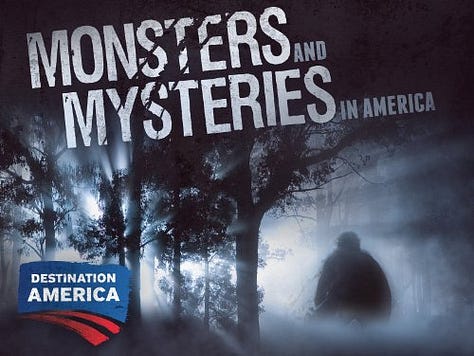
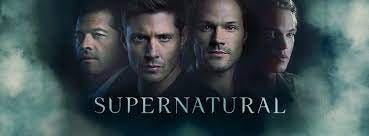
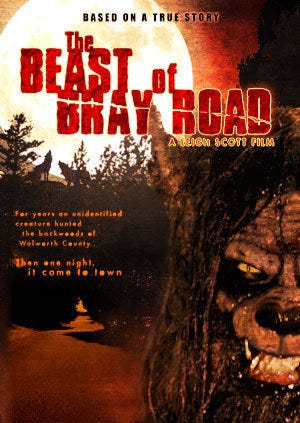
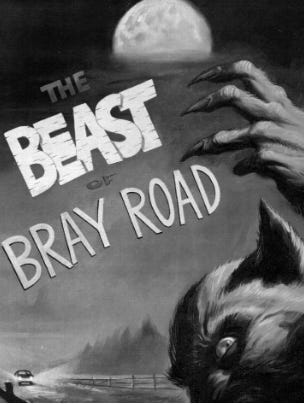


The Beast of Bray Road has influenced the culture of southeastern Wisconsin. In Elkhorn, where many sightings occurred, the annual Beast of Bray Road Festival attracts enthusiasts. This event fosters pride among locals and draws visitors keen to spot the creature or attend events celebrating its lore.
The Beast’s enduring popularity stems from its unsolved mystery and captivating interest in the unknown. New eyewitness accounts and theories enrich the legend, making it compelling for both believers and skeptics. Additionally, the Beast’s cultural significance as a symbol of the Midwest’s mysteries illustrates the region’s untamed wilderness and enigmatic forces.
The Impact of the Beast of Bray Road on the Local Community & Environment
The legend of the Beast of Bray Road has greatly impacted the local community and environment. On one hand, it has boosted tourism in Elkhorn and neighboring towns as visitors seek to catch a glimpse of the elusive creature. This has raised awareness of the region's natural beauty and cultural heritage, as many learn about southeastern Wisconsin's history and folklore.
However, the legend has also instilled fear in some locals, particularly where sightings have been reported. The idea of a mysterious creature can be unsettling, prompting some to avoid certain roads or wooded areas after dark. If the Beast were discovered to be a new species or hybrid, it could significantly impact the local ecosystem, potentially disrupting the delicate balance of the environment.
Ultimately, the community and cryptozoology experts must weigh the benefits of tourism against potential environmental impacts and psychological effects on residents as this legend continues to evoke interest.
Midwest Legends & Their Connections to the Beast of Bray Road
The Beast of Bray Road is not an isolated legend; the Midwest region of the United States is rich in myths, legends, and folklore that date back centuries, with many originating from Native American tribes. These stories, passed down through oral tradition, involve spirits, ghostly encounters, and mythical creatures. Some of the most well-known legends include the Wendigo, the Thunderbird, the Michigan Dogman, the Hodag, and the Ozark Howler. These tales have been adapted and evolved over time, yet they still hold a special place in the cultural fabric of the region. Let’s take a closer look at some of these legends and explore whether they have any connection to the Beast of Bray Road.
Wendigo
The Wendigo is a significant legend among the Native American tribes of the plains and Great Lakes regions. This creature is often portrayed as a monstrous, human-like figure with a skeletal appearance and an insatiable hunger. According to legend, the Wendigo possesses people, compelling them to commit heinous acts such as cannibalism and murder. The Wendigo’s association with greed and unchecked hunger renders it a feared and malevolent entity in Native American folklore. Although the traits of the Wendigo differ significantly from those of the Beast of Bray Road, the supernatural aspect of both legends reflects deeper cultural fears of unknown, predatory creatures that roam the wilderness.
Thunderbird
In contrast to the grim nature of the Wendigo, the Thunderbird is a more positive figure in Native American mythology. Described as a powerful, bird-like creature, the Thunderbird is believed to control the weather, summoning storms and lightning. According to legend, the Thunderbird serves as a divine messenger, bringing rain to nourish the land. Although not directly related to the Beast of Bray Road, the Thunderbird represents another example of the connection between the natural world and the supernatural in Midwest folklore. It demonstrates how mythological creatures have been used to explain natural phenomena and instill a sense of reverence for the forces of nature.
Michigan Dogman
Another notable cryptid is the Michigan Dogman, a legend that dates back to 1887 in Wexford County, Michigan. The Dogman is described as a towering, 7-foot-tall bipedal creature with the body of a man and the head of a canine. Its eyes are said to glow blue or amber, and its howl is often compared to a human scream, which adds to its fearsome reputation. One particularly interesting aspect of this legend is that sightings are reported to occur only every 10 years, specifically in years that end in the number 7. This cyclical nature of the Dogman’s appearances adds an intriguing layer of mystery to the story, much like the periodic sightings of the Beast of Bray Road.
Hodag
Then we have the Hodag, one of the more unusual creatures in the cryptid community. Often called the “platypus of cryptids,” the Hodag is a strange and fearsome beast that looks like a large carnivore with bull-like horns and a row of thick, curved spines running down its back. According to legend, the Hodag was born from the ashes of a cremated ox, symbolizing the collective suffering the animals endured at the hands of their masters. This peculiar creature is heavily featured in Paul Bunyan folklore and is closely associated with Rhinelander, Wisconsin, where it has become a local icon. While the Hodag doesn’t share any physical similarities with the Beast of Bray Road, its origins in Midwestern legend connect it to the broader tapestry of cryptids in the region.
Ozark Howler
Next, we turn our attention to the Ozark Howler, a creature rich in Arkansas folklore, my home state. Growing up as an Arkansas native, I’ve heard many stories about this cryptid, which is said to resemble a bear with a shaggy gray coat and reportedly roams the Ozark Mountains. Sightings of the Ozark Howler continue, partly because bears are commonly seen throughout Arkansas, especially in the state’s mountainous and heavily forested regions. The Howler’s eerie howl has given rise to its name and added to the mystery surrounding it, similar to the disturbing howls attributed to other cryptids like the Beast of Bray Road and the Michigan Dogman.
Cultural Connections & the Role of Folklore
The myths and folklore of the Midwest and Mid-South, like the Ozark Howler, are vital in preserving these regions' cultural and historical heritage. These tales transmit knowledge and values across generations, reflecting the beliefs and experiences of local communities. They provide insights into how people viewed nature and formed their sense of identity.
Many stories, such as those about shapeshifters, are similar to the Beast of Bray Road, suggesting a cultural fascination with the unknown that drives interest in cryptids. Folklore entertains and conveys moral lessons, reinforcing social cohesion within communities.
Exploring the Connections
The stories of the Michigan Dogman, the Hodag, the Ozark Howler, and other regional legends present intriguing parallels to the Beast of Bray Road. Many of these creatures share traits with the Beast, whether through their frightening physical descriptions, supernatural abilities, or ties to wild regions where human activity intersects with untouched nature. The cultural importance of these creatures and their lasting presence in local folklore also reflect our collective fascination with the unknown.
Exploring these connections illuminates why the legend of the Beast of Bray Road has such enduring appeal. Like the other creatures that linger in the lore of the Midwest, the Beast connects with our desire to comprehend what lies beyond the limits of the known world. Whether it is a cryptid, a symbol of nature's untamed power, or something more supernatural, the Beast continues to enthrall us, much like the legends that have come before it.
Cryptozoology: The Search for Hidden Creatures
Cryptozoology studies unknown animals, termed "cryptids." Although mainstream science often views these creatures as myths, cryptozoologists strive to discover and classify them through field investigations, eyewitness accounts, and analysis of evidence like footprints and hair samples. This discipline potentially reveals new species, especially in remote areas. Many once-mythical animals, like the giant squid and the okapi, have been formally recognized due to scientific inquiry. Advances in technology, such as DNA analysis and satellite imaging, enhance cryptozoologists' ability to explore unknown fauna. Traditional fieldwork combined with eyewitness accounts is common for research on the Beast of Bray Road. Researchers employ trail cameras and remote sensing tools to capture evidence, hoping to gather insights into the creature's biology. However, pursuing cryptids poses significant challenges, necessitating a careful separation of fact from speculation.
Skepticism & Criticism of Cryptozoology
Cryptozoology faces skepticism from the scientific community, as critics argue it lacks rigorous methodologies and relies too heavily on anecdotal evidence. Detractors label it as pseudoscience, claiming the creatures are mere figments of imagination or misidentified animals. It predominantly focuses on unproven creatures, blurring fact and folklore, and struggles to substantiate claims of undiscovered species due to insufficient empirical evidence. Critics also suggest cryptozoologists might be biased, interpreting ambiguous evidence in ways that favor the existence of cryptids instead of objectively analyzing the data.
The Case for Cryptozoology
While cryptozoology faces criticism, it is essential to recognize the potential value of the field. As mentioned earlier, many animals once dismissed as mythical or legendary have been discovered through careful scientific investigation. The vastness of our planet, with its many unexplored regions, still presents opportunities for discovering new species. Whether in the depths of the oceans or the dense canopies of rainforests, unknown creatures may be lurking, waiting to be studied and cataloged by science.
However, the field does have its limitations. Studying cryptids—creatures that have not yet been conclusively proven to exist—requires a careful balance between curiosity and scientific discipline. Without verifiable physical evidence, cryptozoological research can sometimes drift into speculation, making it challenging to separate fact from fiction. Researchers in this field must maintain objectivity, ensuring that their investigations are guided by data rather than preconceived notions or personal beliefs.
Ultimately, while cryptozoology may not yet be fully embraced by mainstream science, it continues to offer valuable insights into the unknown. Its ongoing investigations into creatures like the Beast of Bray Road push the boundaries of what we know about the natural world, and in doing so, cryptozoologists keep the spirit of discovery alive.
Ethical Considerations in Cryptozoological Research
Cryptozoological research has ethical concerns, especially regarding studying elusive and potentially rare creatures like the Beast of Bray Road. One significant issue is the potential harm to the animals being investigated. If the Beast—or any cryptid—is discovered, researchers must minimize harm and ensure that their investigations do not negatively impact the animal's population or habitat, especially if the creature is rare or endangered.
Beyond the creatures themselves, there are also ethical considerations concerning the local communities in areas where these legends thrive. In some regions, cryptids hold significant cultural or spiritual meaning, and exploiting these communities for information or resources can be damaging. Researchers must approach their work with cultural sensitivity and respect for local traditions. Additionally, there are concerns regarding the accuracy and reliability of the information gathered through cryptozoological research. Without empirical evidence, there is a risk of misinterpretation or misuse of this information, resulting in further confusion or exploitation of the legend.
The Future of the Beast of Bray Road
The future of the Beast of Bray Road, as both a legend and a possible living creature, is uncertain. Although sightings have decreased, the legend remains alive and captivating scientific and cultural communities. Investigations may illuminate the creature's existence or lead to its discovery, but public interest might wane as new mysteries emerge.
The ongoing sightings and investigations of the Beast could have significant implications. Scientifically, its existence would challenge current views of the natural world and spark new research avenues in biology and ecology. Culturally, the legend fascinates, attracting tourists and benefitting the local community through events like the Bray Road Beast Festival.
Despite its popularity, challenges arise, such as the risk of commercialization diluting its cultural importance. If proven real, the creature's impact on local wildlife is a concern. However, if it has existed for decades, it likely fits within the local ecosystem rather than disrupts it.
Given its cultural significance, interest in the Beast of Bray Road will likely persist. Research may garner more attention and discoveries, while the legend continues to inspire art and media. This interest must be balanced with ethical respect for the community and environment during investigations.
The Legacy of the Beast of Bray Road
The legend of the Beast of Bray Road has evolved from a local Wisconsin tale into a global cultural icon. From its beginnings as a rural myth to its status as a fascinating cryptid, the Beast has captivated countless people across generations. Shaped by eyewitness accounts, scientific investigations, and references in pop culture, the legend has taken on a life of its own. While definitive proof of the Beast's existence may never surface, its legacy will continue to inspire and intrigue for generations to come. I hope this exploration of the Beast of Bray Road has shed light on the enduring mystery of this creature and the fascinating world of cryptozoology. Keep exploring the unknown with curiosity, and remember—many mysteries in the natural world are still waiting to be uncovered.
Eyewitness Timeline
As promised, here is a chronological list of the sightings of the Beast of Bray Road according to Linda Godfrey’s book The Beast of Bray Road: Tailing Wisconsin’s Werewolf.
1929: The Wild Man of LaGrange is reported - not a “werewolf” sighting per se but perhaps the source of some local legends.
1936: Mark Schackelman sees creature on Indian mound behind St. Coletta’s institution, Jefferson County, standing upright, uttering “gadarrah.”
1960s-1970s: The Eddy, large hairy creature, is rumored to stalk rural East Troy.
1964: Rural Delavan man sees creature crossing road upright and hurdling fences on either side, near Delavan. Describes it as more like “Bigfoot.”
1964: Richard Moe encounters large, black creature with furry paws; creature rocks car of parked couple in Wadsworth, Illinois (just south of Wisconsin border).
1970s: The Bluff Monster, large hairy creature, is seen by campers around Bluff Road, near LaGrange.
1972: At a Jefferson County farm, a creature slashes horse, leaving scratch marks on house seven feet above ground; incident is investigated by DNR agent David Gjetson.
1972: In Milwaukee, Kim Del Rio sees upright, doglike creature on neighbor’s lawn.
Fall 1980: Ronald Nixon observes bipedal hairy hominid on shore of Bark River, north of Whitewater.
Winter 1980: Marv Kirschnik, Marinette County, sees seven-foot-tall, dark-colored biped with glowing yellow eyes from snowmobile trail.
Fall 1989: Scott Bray observes creature by rock pile on Bray Road, on all fours, dog-or coyote like but larger.
Fall 1989: Lori Endrizzi sees creature kneeling by side of Bray Road, holding “roadkill.”
December 1990: Heather Bowey, Russell Gest, and three young cousins observe creature near creek near Loveland Road, Bray Road vicinity, both upright and on all fours.
March 1990: Mike Etten sees creature holding roadkill on Bray Road, sitting on haunches.
Fall 1991: Sharilyn Smage observes creature in cornfield on Bray Road, on all fours.
October 1991: Doris Gipson sees creature near cornfield on Bray Road, running upright, lunging for her car.
November 1991: Tracks of “Pottsy” are seen in snow on Potter’s Road near Simons Feed Mill, Bray Road vicinity.
November 1991: “Jennifer,” twenty-year-old radio call-in guest, and her boyfriend see creature running across road on two legs, probably Elkhorn vicinity.
November 1991: The Robert Bushmans see creature dash across road on all fours on Highway 11 between Elkhorn and Delavan at 10:00 am.
April 1992: Martha Kerkman sees creature in New Munster, western Kenosha County, on four legs Easter morning; friend saw same animal next day.
August 1992: Tom Brichta and Chris Maxwell observed creature near cornfield on Highway 106, Jefferson County, walking upright.
1992-1993: Mitch and friend run over large creature on Highway A, north of Delavan, western Walworth County; the creature, six to seven feet long, is stretched out on road, apparently dead.
November 1995: “Sandy Doe” is menaced by huge, doglike creature on four legs near east shore of Lauderdale Lakes, at dusk.
February 1996: Glen North sees very fast quadruped, “taller than a dog,” crossing Highway 12 between LaGrange and Whitewater in Walworth County.
1998: Jessica Anderson see creature at her in-laws’ window in Williams Bay, near Geneva Lake.
1999: Young girls see huge, large-headed, wolflike animal in their yard near Marshfield, Wood County, Wisconsin.
June 2001: Nate Sterken hears bloodcurdling roar in woods near Highway P, north of Delavan; his father heard same sound ten years earlier.
References
Godfrey, L. S. (2003). The Beast of Bray Road: Tailing Wisconsin’s Werewolf. Big Earth Publishing. https://amzn.to/4bxb15a
Weiser-Alexander, K. (July 2020). The Beast of Bray Road, Wisconsin – Legends of America. (n.d.). https://www.legendsofamerica.com/beast-of-bray-road/
Wikipedia contributors. (2023, February 23). Beast of Bray Road. Wikipedia. https://en.wikipedia.org/wiki/Beast_of_Bray_Road
DiRienzo, D. (2020, January 2). Allegedly Home To An Unidentified Beast, Bray Road In Wisconsin Is One Street You’ll Want To Avoid. OnlyInYourState®. https://www.onlyinyourstate.com/wisconsin/beast-of-bray-road-wi/
Nadolski, E. (2020, July 10). Man says he saw Beast of Bray Road in Lyons. My Racine County. http://www.myracinecounty.com/news/burlington/2020/man-says-he-saw-beast-of-bray-road-in-lyons/
Huberty, M. Lake Geneva Ghosts - The Beast of Bray Road 30th Anniversary. (n.d.). https://www.americanghostwalks.com/articles/lake-geneva-ghosts-the-beast-of-bray-road
Hunter, J. (2022, December 9). ‘Beast of Bray Road’ writer Linda S. Godfrey dies at 71. Wisconsin Newspaper Association. https://wnanews.com/2022/12/08/beast-of-bray-road-writer-linda-s-godfrey-dies-at-71/




